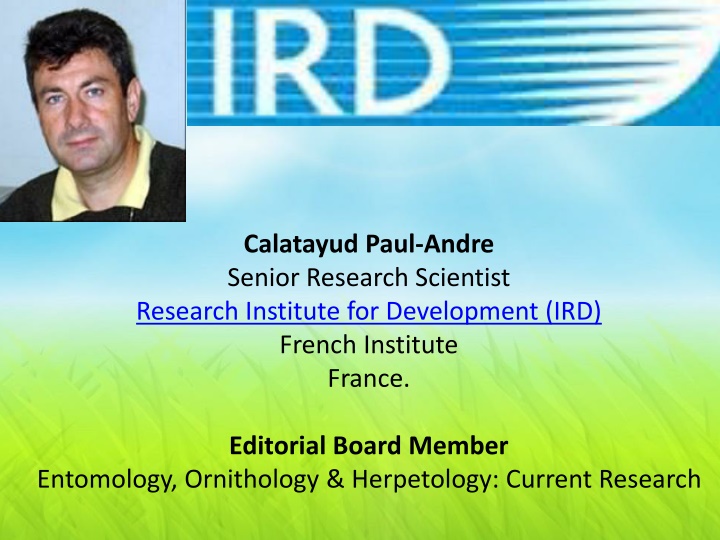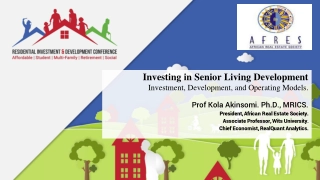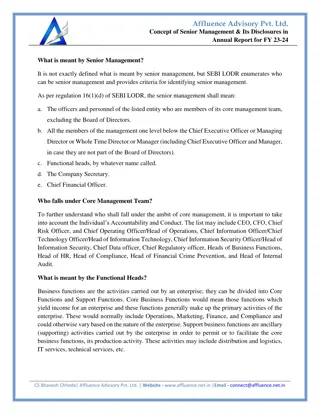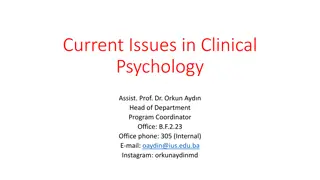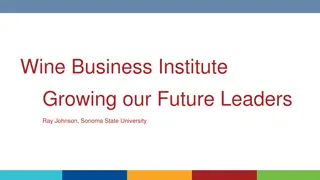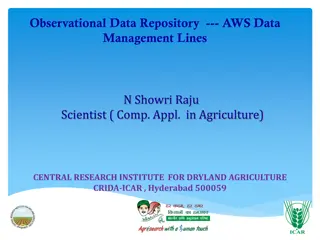Senior Research Scientist - Dr. Calatayud, Research Institute for Development
Dr. Calatayud, a Senior Research Scientist at the Research Institute for Development (IRD) in France, specializes in entomology with a focus on insect-plant interactions, behavior, and physiology. His extensive research experience includes field and laboratory studies in South America and Africa, leading to numerous publications and contributions to esteemed journals and editorial boards.
Download Presentation

Please find below an Image/Link to download the presentation.
The content on the website is provided AS IS for your information and personal use only. It may not be sold, licensed, or shared on other websites without obtaining consent from the author.If you encounter any issues during the download, it is possible that the publisher has removed the file from their server.
You are allowed to download the files provided on this website for personal or commercial use, subject to the condition that they are used lawfully. All files are the property of their respective owners.
The content on the website is provided AS IS for your information and personal use only. It may not be sold, licensed, or shared on other websites without obtaining consent from the author.
E N D
Presentation Transcript
Calatayud Paul-Andre Senior Research Scientist Research Institute for Development (IRD) French Institute France. Editorial Board Member Entomology, Ornithology & Herpetology: Current Research
Biography Dr. Calatayud is a Senior Research Scientist of Research Institute for Development (IRD), a French Institute. A native of France, he has experienced field and laboratory studies in South America at CIAT (Colombia) and Africa at ICIPE (Kenya). Dr. Calatayud is an entomologist with experience in insect-plant interactions (including the third trophic level, the parasitoids) ; insect behaviour and insect/plant chemistry (including volatiles). He has published more than 50 papers in refereed journals, written 4 books and 3 book chapters. His professional services include: referee of several international journals (e.g. Bulletin of Entomological Research, Crop Protection, Entomologia Experimentalis et Applicata, European Journal of Entomology, Florida Entomologist, Journal of Agriculture and Food Chemistry, Journal of Applied Entomology, Journal of Insect Behavior, Physiological Entomology); Member, Editorial board of ISRN Entomology and International Journal of Insect Science, Science Advisory Panel, International Fundation for Science (IFS, Sweden). Editorial board of ISRN Entomology and International Journal of Insect Science, Science Advisory Panel, International Foundation for Science (IFS, Sweden). Dr. Calatayud is a Senior Research Scientist of Research Institute for Development (IRD), a French Institute. A native of France, he has experienced field and laboratory studies in South America at CIAT (Colombia) and Africa at ICIPE (Kenya). Dr. Calatayud is an entomologist with experience in insect-plant interactions (including the third trophic level, the parasitoids) ; insect behaviour and insect/plant chemistry (including volatiles). He has published more than 60 papers in refereed journals, written 4 books and 9 book chapters. His professional services include: referee of several international journals (e.g. Bulletin of Entomological Research, Experimentalis et Applicata, European Journal of Entomology, Florida Entomologist, Journal of Agriculture and Food Chemistry, Journal of Applied Entomology, Journal of Insect Behavior, Physiological Entomology); Member, Crop Protection, Entomological
Research Interest Plant physiology linked to insect resistance Insect-plant interactions study Insect behaviour and insect physiology Host selection and acceptance by Lepidoptera and parasitoids
Communication Pheromone, light, & sound Pheromone- chemical released by an animals that affects the behavior or development of other members of the same species through the sense of smell or taste Example: ant trails- following a pheromone. Sound- chirping of insects Attract mates & warn other males away from territories Example: crickets use sound by rubbing a scraper located on one forewing against a vein on the other forewing Example: mosquitoes use for mate
Communication Pheromones are also used as identification of an animal or home Pheromones can attract a mate
Behavior in Honeybees Social insects- some individuals gather food, others protect the colony, and other reproduce. Social insects allow for more independence and dividing work in each colony Honeybees have innate behavior- genetically determined behavior
Three types of honeybees: worker bees, queen bee, and drones Worker bees- non-reproductive females that make up the vast majority of the hive population Workers perform all duties except reproduction. Queen bee- only reproductive female in the hive, and her only function is to reproduce Drones- males that develop from unfertilized eggs, and their only function is to deliver sperm to the queen
Behavior in Honeybees Worker bees must feed the drones because their mouth parts are too small to obtain nectar from flowers
Worker Bees Lifetime = six weeks Workers feed honey and pollen to queen, drones, and larvae- during this stage, they are called: nurse bees Royal jelly- high-protein substance worker bees feed to the queen and youngest larvae
Worker Bees When a worker bee stings another animal, it dies a day or two later
The Queen Bee Queens develop from larvae that are constantly feed royal jelly Queens mature and secrete apheromone called the queen factor- prevents other female larvae from developing into queens. Queens usually mate once, but lay thousands of eggs Queens role is to reproduce. Hive becomes over-crowded, and the queen bee will leave taking worker bees with her causing a swarm. They search for a new location to build a new hive
The Dances of the Bees Round dance- food near hive
The Dances of the Bees Waggle dance- food far from hive
Altruistic Behavior Altruistic behavior- aiding of other individuals at one s own risk or expense Example: sting and cause death Kin selection- mechanism of propagating one s own genes by helping a related individual reproduce
Approved By E-signature:
OMICS Group Open Access Membership Open Access Membership OMICS INTERNATIONAL Open Access Membership enables academic and research institutions, funders and corporations to actively encourage open access in scholarly communication and the dissemination of research published by their authors. For more details and benefits, click on the link below: http://omicsonline.org/membership.php
